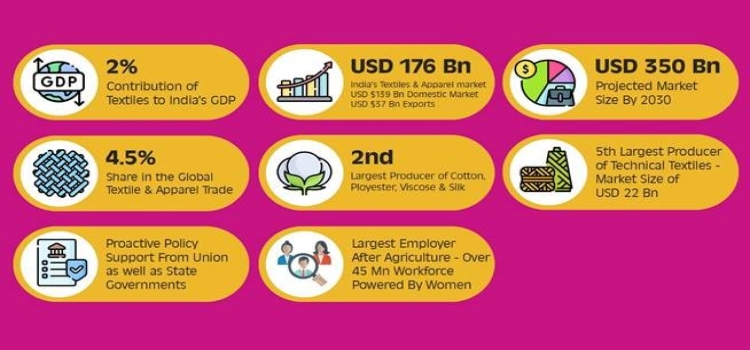
Bharat Tex 2025, India’s largest global textile event,
Context: Bharat Tex 2025, India’s largest global textile event, was held in New Delhi, showcasing India’s textile advancements and global trade potential.
- The Indian government aims to triple textile exports from ₹3 lakh crore to ₹9 lakh crore by 2030, leveraging sustainability, innovation, and policy support.
Overview of India’s Textile Sector:
- 6th Largest Exporter: India holds 8.21% share in global textile trade (2023-24).
- Employment Generator: Provides direct jobs to 45 million people and indirect livelihood to over 100 million, including rural and women workers.
- Export Markets: USA and EU account for 47% of India’s textile exports.
- Government Initiatives: ₹10,683 crore allocated under Production Linked Incentive (PLI) Scheme to boost manufacturing.
Booming Categories in the Textile Industry:
- Technical Textiles:
- High-performance textiles used in aerospace, medical, and infrastructure.
- Projected to reach $300 billion by 2047.
- Sustainable & Organic Textiles: Rising demand for eco-friendly fabrics like organic cotton, bamboo textiles, and biodegradable materials.
- Digital & Smart Textiles: AI-driven manufacturing, IoT-based quality control, and 3D weaving revolutionizing production.
- Handloom & Artisanal Textiles: Government promoting handloom clusters to preserve India’s rich weaving heritage.
- Man-Made Fibre (MMF) and Apparel: Government focus on synthetic textiles, MMF apparel, and high-value garments.
Key Government Schemes Supporting the Textile Sector:
- PM MITRA (Mega Integrated Textile Region & Apparel Parks): 7 mega parks with world-class infrastructure and $10 billion expected investment.
- Production Linked Incentive (PLI) Scheme: ₹10,683 crore incentive for MMF fabrics, technical textiles, and high-value apparel.
- Samarth Scheme: Skilling 10 lakh artisans and textile workers to bridge skill gaps.
- Integrated Processing Development Scheme (IPDS): Support for eco-friendly processing units to meet global environmental standards.
- National Handloom Development Programme (NHDP): Support for handloom weavers, market linkages, and financial assistance.
- Raw Material Support Schemes: Cotton, jute, silk, and wool promotion initiatives to enhance quality and yield.
Challenges Facing India’s Textile Industry:
- Trade Deficit & Competition: India faces high import costs of synthetic fibres and tough competition from China, Bangladesh, and Vietnam.
- Lack of Technology & Automation: Slow adoption of AI, robotics, and smart textiles limits productivity.
- Environmental Concerns: Water-intensive production and pollution from dyeing units affect sustainability goals.
- Infrastructure Gaps: Need for modern textile parks, better logistics, and export-oriented clusters.
- Skilled Workforce Shortage: Limited technical training in high-value textiles like technical and MMF-based fabrics.
Way Ahead:
- Boosting Export Competitiveness: Strengthen free trade agreements (FTAs) with key markets like the EU and USA.
- Investment in Technology & Automation: Encourage AI-driven textile manufacturing, automated weaving, and sustainable practices.
- Expanding Technical Textiles & MMF Production: Achieve global leadership in technical textiles through R&D incentives.
- Sustainable and Green Manufacturing: Increase adoption of zero-liquid discharge (ZLD) systems and renewable energy in textile units.
- Infrastructure & Policy Reforms: Accelerate PM MITRA parks, textile hubs, and streamlined regulatory approvals.
Conclusion:
India’s textile industry is on the cusp of transformational growth, driven by government support, innovation, and sustainability. Bharat Tex 2025 has reinforced India’s position as a global textile hub, with a clear roadmap to achieve ₹9 lakh crore in exports by 2030. With strong policy backing, technological advancements, and skilled workforce development, India is set to redefine the global textile landscape.

